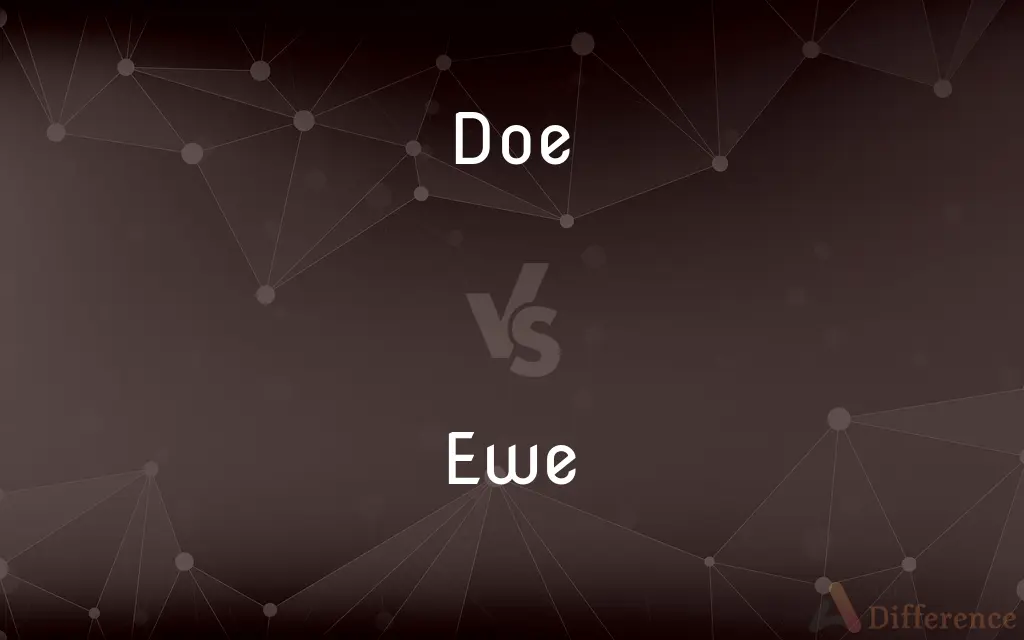Doe vs. Ewe — What's the Difference?
By Urooj Arif & Maham Liaqat — Updated on April 2, 2024
A doe is a female deer, while an ewe is a female sheep, each significant within their respective species.

Difference Between Doe and Ewe
Table of Contents
ADVERTISEMENT
Key Differences
Doe refers to the female of various species of deer, recognized for their grace and agility in the wild. Whereas ewe denotes a female sheep, an animal known for its wool and crucial role in agriculture for both meat and dairy products.
In terms of behavior and habitat, does are generally wild animals found in various environments from forests to grasslands, showcasing adaptability and a strong survival instinct. On the other hand, ewes are domesticated animals, integral to human agricultural practices for centuries, and are primarily raised in controlled farm environments.
The reproductive roles of a doe and an ewe also hold significance in their respective species. Does are known for their ability to give birth to one or more fawns after a gestation period that varies by species, while ewes are known for lambing, often producing twins or singles after about five months of gestation.
When it comes to social structure, does can be part of large herds or smaller family groups depending on the species and environment, showing a flexible social organization. Ewes, however, are usually kept in flocks, reflecting their domesticated nature and the human management of their breeding and daily care.
Regarding their contribution to their ecosystems or human society, does play a key role in maintaining the balance within their natural habitats, affecting vegetation and prey-predator dynamics. Ewes contribute significantly to human economies, providing essential products like wool, meat, and milk.
ADVERTISEMENT
Comparison Chart
Species
Female deer
Female sheep
Habitat
Wild, forests, grasslands
Domesticated, farms
Reproduction
Gives birth to fawns
Gives birth to lambs
Social Structure
Part of herds or family groups
Kept in flocks
Contribution
Maintains ecological balance
Provides wool, meat, and milk
Human Interaction
Mostly observed in the wild
Raised and managed in agricultural settings
Physical Features
Varies widely among species, generally slender and agile
Stocky build, known for their woolly coat
Compare with Definitions
Doe
Known for their graceful and alert nature.
The doe leapt away at the slightest sound.
Ewe
Raised primarily on farms.
Each ewe on the farm produces a significant amount of wool annually.
Doe
Plays a role in maintaining ecological balance.
The presence of does in the area helps control underbrush growth.
Ewe
A female sheep.
The ewe was the first to lead her lambs into the new pasture.
Doe
Prefers natural wild environments.
A doe was spotted near the river in the national park.
Ewe
Lives in flocks.
The ewe stayed close to her flock for protection and socialization.
Doe
Capable of giving birth to one or more fawns.
The doe secluded herself to give birth to her fawn.
Ewe
Provides wool, meat, and sometimes milk.
The ewes are sheared annually to collect their wool for textiles.
Doe
A female deer, especially a female roe, fallow deer, or reindeer.
Ewe
Often gives birth to twins or singles.
The farmer was pleased when the ewe gave birth to healthy twins.
Doe
A female deer.
Ewe
A female sheep, especially when full grown.
Doe
The female of various other mammals, such as antelopes, kangaroos, mice, or rabbits.
Ewe
A member of a people inhabiting southeast Ghana, southern Togo, and southern Benin.
Doe
A female deer; also used of similar animals such as antelope, (less commonly goat as nanny is also used).
Ewe
The Gbe language of the Ewe people.
Doe
A female rabbit.
Ewe
A female sheep, as opposed to a ram.
Doe
A female hare.
Ewe
The female of the sheep, and of sheeplike animals.
Doe
A female squirrel.
Ewe
A member of a people living in southern Benin and Togo and southeastern Ghana
Doe
A female kangaroo.
Ewe
A Kwa language spoken by the Ewe people in Ghana and Togo and Benin
Doe
A female deer or antelope; specifically, the female of the fallow deer, of which the male is called a buck. Also applied to the female of other animals, as the rabbit. See the Note under Buck.
Ewe
Female sheep
Doe
The federal department responsible for maintaining a national energy policy of the United States; created in 1977
Doe
Mature female of mammals of which the male is called `buck'
Common Curiosities
How does a doe differ from an ewe in terms of habitat?
A doe lives in the wild, adapting to environments like forests and grasslands, while an ewe is a domesticated animal raised primarily on farms for agricultural purposes.
Can both does and ewes have multiple offspring at once?
Yes, both can have multiple offspring; does may give birth to twins or even triplets, depending on the species, while ewes commonly give birth to twins or singles.
What is a doe?
A doe is the female of various deer species, often characterized by their agility and ability to adapt to different habitats.
What role does a doe play in the ecosystem?
Does play a crucial role in their ecosystems by maintaining vegetation balance and serving as prey for predators, thereby contributing to the biodiversity of their habitats.
Can a doe be domesticated like an ewe?
While certain deer species can be semi-domesticated, does are generally wild animals, unlike ewes, which are fully domesticated for agricultural purposes.
How are does and ewes important to humans?
Does are valued for wildlife observation, hunting, and their role in ecosystem balance, whereas ewes are essential for providing agricultural products like wool, meat, and milk.
What is the gestation period of a doe compared to an ewe?
The gestation period of a doe varies by species but is generally around 200 days, while an ewe's gestation period is about five months.
What are the primary reasons humans raise ewes?
Humans raise ewes mainly for their wool, meat, and milk, making them a vital part of agriculture and the economy in many parts of the world.
Why is the wool of ewes significant?
Ewe's wool is significant due to its properties like warmth, durability, and its use in textiles, making it a valuable resource in the clothing industry and traditional crafts.
Is the social structure of does similar to that of ewes?
While both may live in groups, does are part of herds or family groups in the wild, reflecting natural social structures, whereas ewes are kept in flocks in a domesticated setting, managed by humans.
Share Your Discovery

Previous Comparison
Conquest vs. Invasion
Next Comparison
Cat vs. PantherAuthor Spotlight
Written by
Urooj ArifUrooj is a skilled content writer at Ask Difference, known for her exceptional ability to simplify complex topics into engaging and informative content. With a passion for research and a flair for clear, concise writing, she consistently delivers articles that resonate with our diverse audience.
Co-written by
Maham Liaqat















































